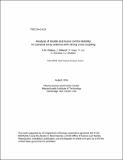Analysis of double stub tuner control stability in a phased array antenna with strong cross-coupling
Author(s)
Hillairet, J.; Wallace, Gregory Marriner; Koert, Peter; Lin, Yijun; Shiraiwa, Shunichi; Wukitch, Stephen James; ... Show more Show less
DownloadAnalysis of double.pdf (991.6Kb)
PUBLISHER_CC
Publisher with Creative Commons License
Creative Commons Attribution
Terms of use
Metadata
Show full item recordAbstract
Active stub tuning with a fast ferrite tuner (FFT) has greatly increased the effectiveness of fusion ion cyclotron range of frequency (ICRF) systems (50–100 MHz) by allowing for the antenna system to respond dynamically to changes in the plasma load impedance such as during the L–H transition or edge localized modes (ELMs). A high power waveguide double-stub tuner is under development for use with the Alcator C-Mod lower hybrid current drive (LHCD) system at 4.6 GHz. The amplitude and relative phase shift between adjacent columns of an LHCD antenna are critical for control of the launched n|| spectrum. Adding a double-stub tuning network will perturb the phase and amplitude of the forward wave particularly if the unmatched reflection coefficient is high. This effect can be compensated by adjusting the phase of the low power microwave drive for each klystron amplifier. Cross-coupling of the reflected power between columns of the launcher must also be considered. The problem is simulated by cascading a scattering matrix for the plasma provided by a linear coupling model with the measured launcher scattering matrix and that of the FFTs. The solution is advanced in an iterative manner similar to the time-dependent behavior of the real system. System performance is presented under a range of edge density conditions from under-dense to over-dense and a range of launched n||. Simulations predict power reflection coefficients (Γ²) of less than 1% with no contamination of the n|| spectrum. Instability of the FFT tuning network can be problematic for certain plasma conditions and relative phasings, but reducing the control gain of the FFT network stabilizes the system.
Date issued
2014-08Department
Massachusetts Institute of Technology. Laboratory for Nuclear Science; Massachusetts Institute of Technology. Plasma Science and Fusion CenterJournal
Fusion Engineering and Design
Publisher
Elsevier
Citation
Wallace, G.M. et al. “Analysis of Double Stub Tuner Control Stability in a Phased Array Antenna with Strong Cross-Coupling.” Fusion Engineering and Design 89, 11 (November 2014): 2748–2754 © 2014 Elsevier B.V.
Version: Author's final manuscript
ISSN
0920-3796